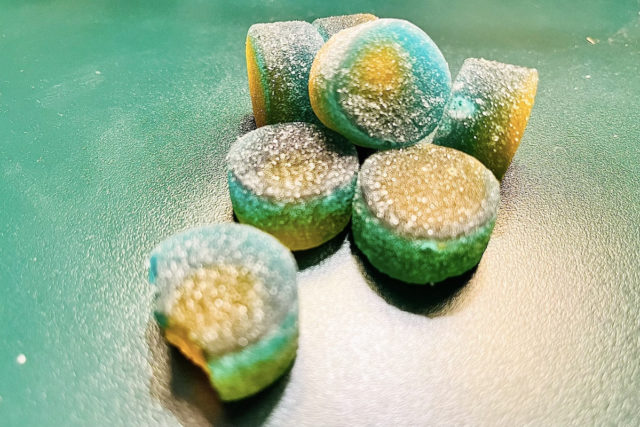

With Oklahoma’s March 7 election closing fast, battle lines are being drawn in the State Question 820 fight to legalize cannabis for recreational use, and child safety has become part of the discussion.
Beyond decriminalizing personal cannabis use for adults age 21 and up, SQ 820 would also expunge records from some low-level cannabis-related crimes and allow other people to be re-sentenced. Yes on 820 proponents also argue it will create new jobs and provide millions in added tax revenue for the state.
But opponents believe all of that comes at a cost that includes more dependency on THC, a strain on water resources throughout the state, and more kids overdosing on marijuana products. Oklahoma voters approved a state question in 2018 legalizing one of the least-restrictive medical marijuana programs in the country.
Tulsa County District Attorney Steve Kunzweiler has been part of the No 820 campaign opposing the recreational marijuana state question. He addressed child safety at a League of Women Voters forum earlier this month and said packaging is intentionally designed to lure children, creating potential health hazards.
“We’re seeing more and more overdoses in children,” he told the forum. “With recreational marijuana, such things now as these gummies and pot-laced Pop-Tarts they’re calling ‘pot tarts’ and other child-oriented marketing ploys, we’re seeing an increase in children, babies, who are having access to these things and overdosing, and an increase in reports to poison control.”
Pediatric exposures have increased in Oklahoma
Since the state’s medical marijuana program was created in 2018, more than 400,000 Oklahomans have obtained patient licenses. With that, the state has seen a rise in pediatric exposures to cannabis products, including gummies and other edibles.
Last year, the Oklahoma Center for Poison and Drug Information received 269 calls related to pediatric exposures to cannabis products for kids under 5, an all-time high since the state’s medical program began in 2018. That year, the center received just 13 calls. That number jumped to 55 in 2019 and 140 the following year. In 2021, the center received 196 calls.
The complaints listed by those calling in 2022 included mild and moderate depression (182), agitation (24), vomiting (21), tachycardia (16), and confusion (14).
Of the 269 pediatric exposures, 76 required an IV or oxygen and three were intubated for a period of time. There were no reported fatalities.
Oklahoma Center for Poison and Drug Information assistant director Kristie Edelen said it is unknown how the numbers might be affected if SQ 820 passes.
“We have seen a remarkable increase in the number of pediatric marijuana exposures over the last several years,” Edelen said. “Some of these patients have required intensive medical care. We’re not sure whether this will continue to rise, level off, or decrease with increased patient knowledge and safe storage.”
Edelen said the center uses data that comes from its hotline, which answers about 40,000 calls annually from adults concerned over everything from spider bites to nicotine poisoning. Some of the data is also compiled from physicians who treat pediatric patients, she said.
Edibles, particularly gummies, continue to be the most attractive to kids, she said.
“Children are not able to distinguish between THC-containing edibles and similar-appearing candies, baked goods, and snacks,” she said.
And when kids get their hands on cannabis products, the packaging is the last line of defense. Edelen said child-resistant packaging can help in some situations but was never meant to be invulnerable.
“No packaging is child-proof, but child-resistant,” she said. “The packaging is only intended to slow a child down from getting into the medication. With child-resistant packaging in play, it is the intent that an adult or caregiver would have time to stop the child from getting into the medication. If a child is given ample time, they will be able to open packaging that is deemed child-resistant. As with any medications and household chemicals, the Oklahoma Poison Center would recommend keeping marijuana products up and out of the reach of children.”
https://nondoc.com/wp-content/uploads/2023/02/OMMA-Infographic-FINAL.pdf” viewer=”google”]How cannabis stacks up with other potential hazards
While there has been a rapid increase in the number of pediatric exposures to cannabis products, they pale in comparison to many other commonly available household products.
Last year, the center received 1,105 calls regarding pediatric exposures of children age 5 and under to over-the-counter pain relievers like aspirin and ibuprofen.
Household cleaning products proved to be another common hazard. In 2022, the center received 1,438 calls for pediatric exposures to those items.
In 2022, there were a combined 365 pediatric exposures to nicotine gum, tobacco products, and street drugs excluding cannabis. Last year, the center received 264 calls about pediatric exposure to common over-the-counter cold medications.
Ryan Kiesel, who works on behalf of the Yes on SQ 820 campaign, said cannabis isn’t a major problem when compared to other items commonly found in homes that can make kids sick.
“Obviously, marijuana shouldn’t be stored in a place where it’s easily accessible to children. I don’t think anyone would dispute that no matter what side you’re on,” Kiesel said. “But when you look at the broader picture, my gut tells me that the stuff under my kitchen sink is far more dangerous to kids than marijuana is.”
Kiesel said that, when looking at the agency’s statistics, it’s also unknown how cannabis products were stored after they were purchased, which can play a role in ease of access for children.
“When you look at the data, you don’t know if the kids who got a hold of these products were consuming marijuana obtained from the legal market, or if it was obtained from other sources. Or, if it was obtained from the legal market, was it stored in the child-resistant containers it was sold in? As a parent of young children myself, nobody wants to see kids get sick, but I think when you consider that we have over 400,000 medical licenses in the state, with many of those people having children, the safeguards are working fairly well and Oklahoma parents should continue to use common sense to protect kids from marijuana and other far more dangerous household items.”
Oklahoma State University philosophy professor Lawrence Pasternack has studied cannabis policy and trends in Oklahoma and has worked as a patient advocate for the Oklahoma Cannabis Liberty Alliance. He said even with increased pediatric exposures since 2018 the overall problem cannabis products create is relatively negligible.
“The crux of it is there has undoubtedly been a noticeable increase in the number of exposures to edibles and other products like that, in the range of five- to 10-fold,” Pasternack said. “But when you aggregate all of the incidences of pediatric exposures to anything they shouldn’t be consuming, whether that’s dishwasher pods or ibuprofen, cannabis went from 0.02 to 0.36 of all of the incidents. While that’s a significant increase, it’s still a fraction of 1 percent.”
Pasternack said passage or rejection of SQ 820 likely would not matter much in the big picture when it comes to children and cannabis exposure.
“We already have mass cannabis use in the state,” he said. “Anyone who really wants to have access to it has that already. I don’t think the passage of SQ 820 would make a substantial difference in the number of kids exposed to cannabis. If we really want to affect change and reduce those numbers, then we need more education on the dangers and how to avoid kids getting access to it at home.”
OMMA already tracks packaging violations
Some who oppose SQ 820 have said recreational cannabis would mean more products aimed at children, which in turn would make it more likely for kids to get sick from ingesting them. Tulsa County Health Department executive director Bruce Dart said during the League of Women Voters forum that such a result is not what the state needs.
“Marijuana food products are frequently colorful, they’re sweet and they’re branded with cartoons to attract children,” Dart said. “And they’re available in kid-friendly forms such as gummy bears and lollipops. Products sometimes resemble familiar brands like Butterfinger or Kit Kats. The bottom line is health care experts are really concerned with what recreational marijuana does.”

When Oklahoma Medical Marijuana Authority inspectors visit dispensaries and processors of raw cannabis, among the items on their checklist is packaging that might be attractive to kids. But according to data obtained from the OMMA, inspectors don’t find many that fit that bill during their visits. From May to December last year, OMMA inspectors found only five such instances at dispensaries. There were eight violations found at processors.
Inspectors found another eight violations at dispensaries for products with advertising that depicted cartoon characters, toys, or a child or person under legal age consuming marijuana, which is against state regulations.
OMMA executive director Adria Berry told NonDoc that inspectors check for anything that might be enticing to children when they conduct on-site inspections, including the use of appropriate child-resistant packaging.
“When our compliance inspectors go out, they are doing everything they can to make sure products sold are safe, and that includes making sure packaging is within the regulations that we have,” Berry said. “But at the same time, it’s up to the parents to make sure their home is safe. I don’t think medical cannabis is easier to get into than Tylenol or other medications, but it is the responsibility of the guardians to keep these products safely away from children.”
When it comes to packaging that can entice children, courts have become a battleground for some companies. Hershey’s sued at least one cannabis producer for trademark infringement for marketing a product with packaging similar to its popular Reese’s Peanut Butter Cups.
“From what we’ve seen, several of those companies have filed trademark infringements and those lawsuits are ongoing,” Berry said. “We do have strict rules about labeling that can be enticing to kids, and that is something our inspectors are always looking for. Of course, I think there’s always room for improvement. We’d like to be able to send more inspectors out, and we’re working on that.”




















